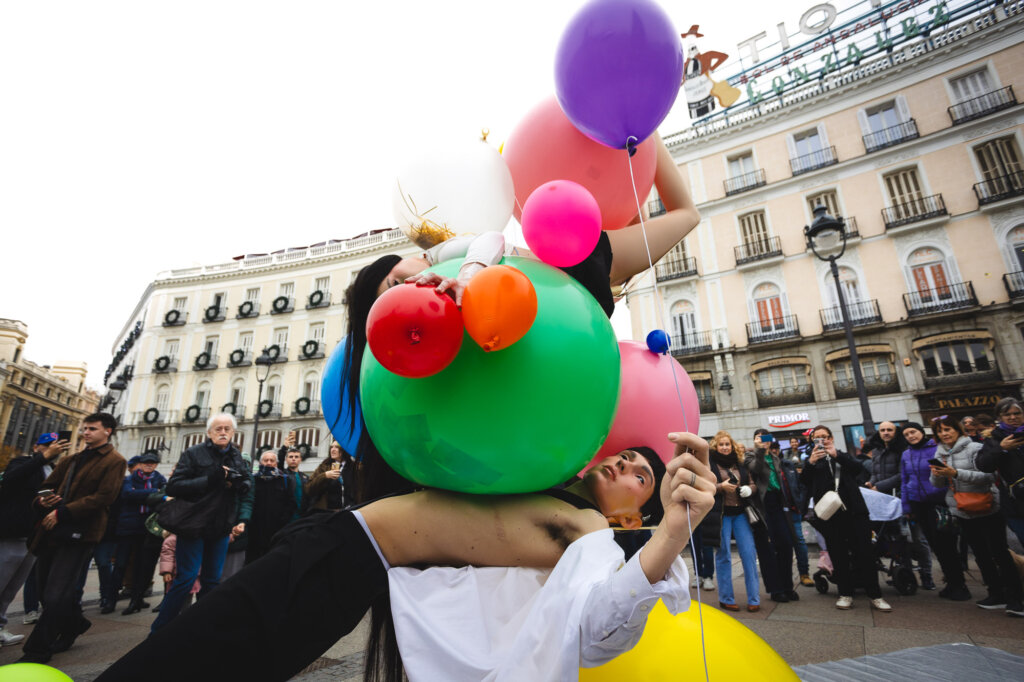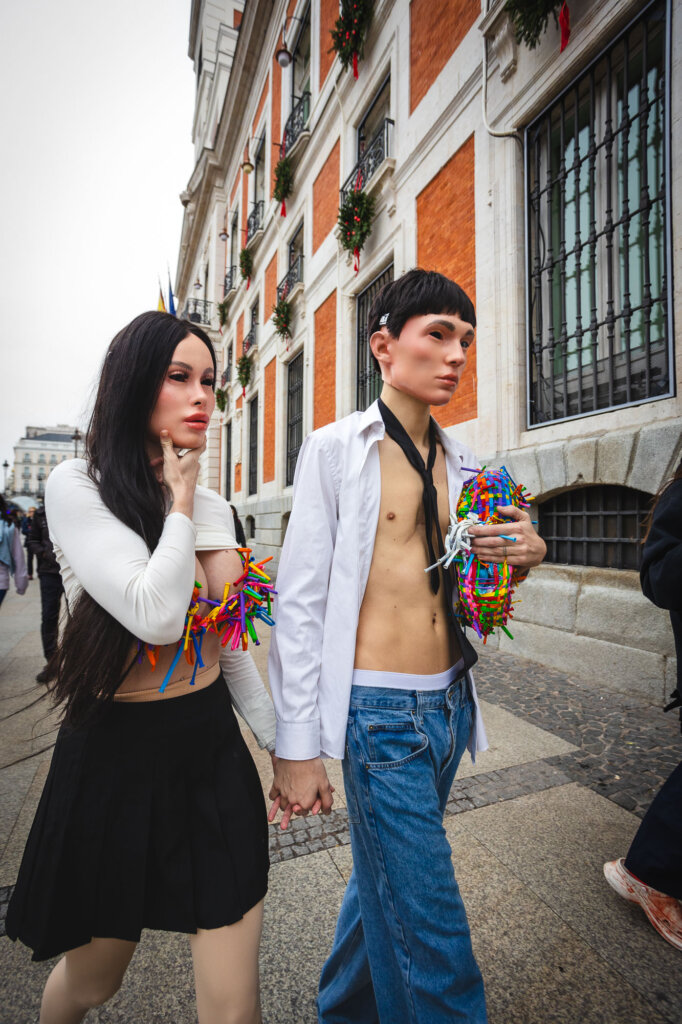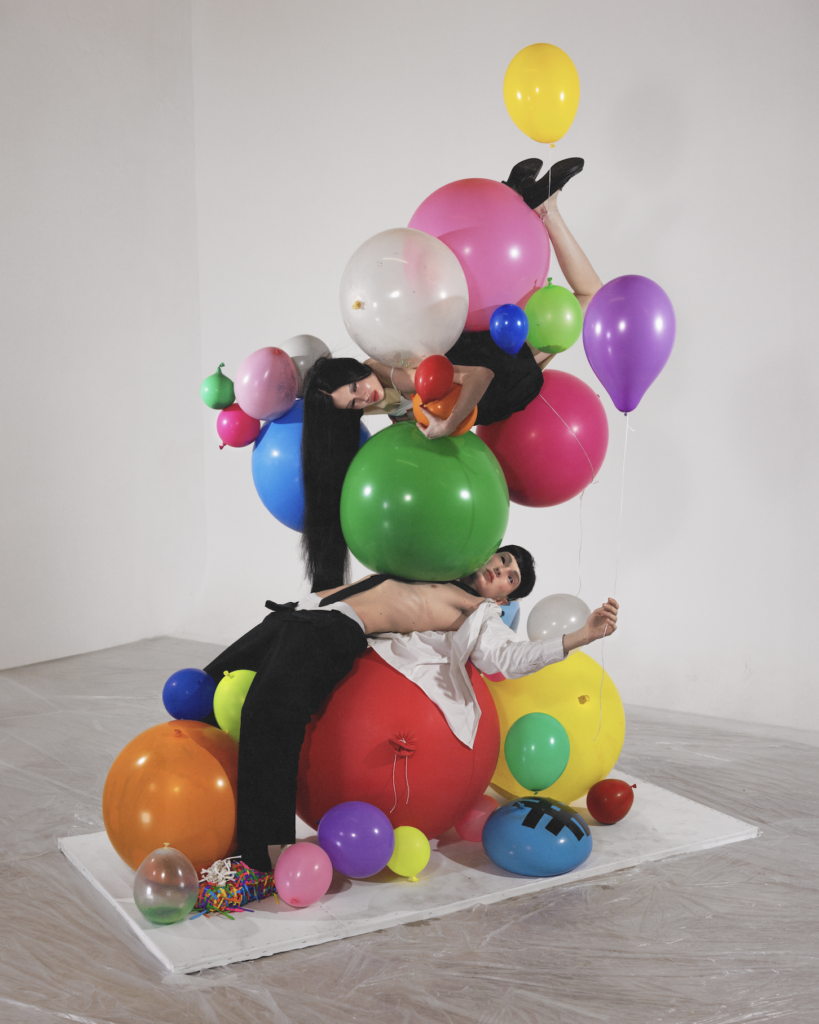
Dreamcore, performance. Filip Custic (2023)
On the pavement, far from the white cube and its delicately ordered, the acrobatically arrangedbodies of filip custic and Virgen María (Maria Forqué), precariously supported by dozens of balloons of various sizes and colours, create a dreamlike structure that decisively occupies public space. dreamcore performance was held in Puerta del Sol (Madrid) on December 2023.
Shielded behind hyperrealistic helmets, the artists blend into the urban landscape wheretheir skin, lack of expression, and the polished plastic of the balloons are mistaken for the marble-like gleam of urban statues. However, the impossible poses of filip custic and Virgen María quickly arouse doubt.
Upon close scrutiny, the work reaffirms itself as an anti-monument, as a counter-sculpture confronting the dignified names of politicians, military figures, and explorers that populate the city’s squares, corners, and roundabouts. The unstable stillness of the piece thus establishes a committed kinship within street artists who make a living by freezing their figure for hours, with wandering performers, with cardboard robots, with imposing inflatable plush toys, and ultimately, with all those who experience the city creatively amidst the rigid stasis of granite and asphalt.

Dreamcore, performance. Filip Custic (2023)
Under the title dreamcore, Filip Custic, always interested in internet culture, dehumanization processes, filtering, and retouching, abandons the virtual space in an exercise of translation where these realities materialize as a simulation on the metropolis horizon.

Dreamcore, performance. Filip Custic (2023)
Between the hard and the soft, the ethereal and the concrete, the skin and the pixel, the artist generates a sculpture that allows him to inhabit the creative interstice that distances these polarized binaries, marked by cracks and gaps. Twisting the body, contorting bone and muscle into improbable poses, Filip Custic occupies the gap while embracing the risk of being in a space that constantly wavers.
Replicating the mechanics of the city and transferring the lexicon and virtual environments of the streets, dreamcore creates a simultaneously inhospitable, colourful, distant and intimate experience. The square, typically illuminated, cheerful, and decorated, also becomes a desolate place.
The lights and shop windows highlight the virtues of the present while pointing out the harshness of concrete and the city’s miseries. Similarly, the colourful balloons or the spectacular circus poses of Filip Custic and Virgen María converse with the eerie frozen smiles of the artists’ faces. The childish and playful aspects of the piece reinforce the ongoing dialogue with what is unsettling. Filip Custic once again treads the liminal path of the uncanny: the work exists between a birthday party and a dissected body, between a “piñata” and a humanoid robot, between a square and a backroom, between sculpture and flesh.
Moreover, breaking away from solipsistic and self-referential gestures, the artist embodies the logic of the internet while embracing the interaction inherent to the metropolis. The public is invited to move from being spectators to active participants in the piece. Without fear of falling, the artist invites the audience to burst the balloons that support and ensure his balance.
The work relies on pedestrians and bursts, on the curious, the pushpin, and the pin.
After the shock shock, the balloons reveal their contents: confetti, money, glitter, coloured liquids… What was previously mistaken for marble or the pedestal of a strange monument is then unveiled as a live comunal ASMR session where haptic pleasure and sensory enjoyment invade the praxis.
In the end, after the balloons disappear, after demolishing the sculpture, doubt is intuited and the operative fiction that sustained the work becomes evident, exposing the contemporary.
What was previously unstable is revealed as solid, and doubt dissipates. Nevertheless, as if it were a lucid dream, the pact is sealed, and the square regains its undisturbed normality.

Dreamcore. Filip Custic (2023)
